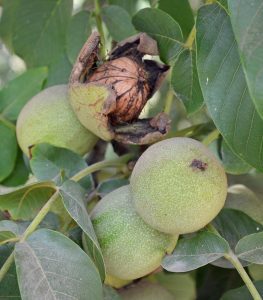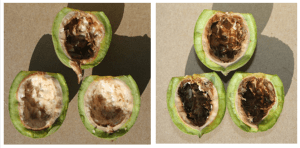
As walnut growers struggle to survive another tough year in the market and look for ways to maximize crop value, the ethylene-based plant growth regulator Ethephon could be of use to some.
Since recouping costs lost to a critically low walnut market won’t be possible this year, garnering the highest quality nuts at harvest will be crucial. Sacramento County Orchard System Advisor Katherine Jarvis-Shean hopes Ethephon can help assist some growers in that mission.
While she says she knows growers won’t break even this year, the benefits of using Ethephon could at least allow for the harvest to pay for itself by helping to provide a superior product.
“Quality is king right now for pricing,” Jarvis-Shean said.
The value of using Ethephon this year could also come in the form of saving on labor costs for growers who find it more cost effective to spread the harvest out on acreage with the aid of Ethephon.

“It is an additional input, but you’re paying for all these people on staff, and it will be more expensive to pay them overtime once they get past eight or ten hours,” she said, “so the cost of keeping them overtime might still be more than the cost of Ethephon.”
Jarvis-Shean said this probably isn’t the year for growers who have never used Ethephon to experiment with it, but those who adhere to the “art” and “science” philosophy of how to properly use Ethephon, could indeed benefit from it.
“Generally, for people who use it consistently as a tool in their toolbox, it’s looked on as a really valuable tool in helping manage the workflow of harvest and to maintain high quality at the same time as spreading out the workload,” she said.
Ethephon can speed up hull cracking and harvest by four to seven days depending on variety, season and temperature conditions. It can also garner lighter colored kernels, which could bring more value to a harvest. The factors affecting the decision to use Ethephon differ from orchard to orchard, but in any situation, it’s vital the product is applied properly to enhance its potential.
Growers must assess the cultural status of their orchard to be able to make that decision, according to Bob Beede, UC farm advisor emeritus for King’s County, who has spent more than 20 years researching Ethephon.
With little to no incentive to recover the costs of doing so, Beede says growers will likely question the value of applying Ethephon this year, but understands they are also caught in a Catch-22.
“If they don’t deliver nuts of the lightest color, then they’re going to get even less money for their walnuts,” he said. “It puts the grower in an extremely discouraging position and it’s one that all of us current and retired UC people have a great deal of empathy for.”
Over the years, many longtime users of Ethephon have developed their own recipe for success, Beede explained.
“Like all plant growth regulators, the success in its use is 50% science and 50% art,” he said.

Application Timing
A key element to successful Ethephon use is its application in cooler weather conditions, after the completion of packing tissue brown (PTB). At PTB, the walnut meat is fully mature and beginning to pull away from the internal packing tissue of the shell. Individual nuts have reached PTB when the shell tissue surrounding the walnut “meat” has acquired a uniform, oak color. Packing tissue interspersed with light brown and white tissue has not completed full maturation, Beede explained.
One reason he emphasizes the importance of timing application to PTB is because growers looking for the lightest meats possible might be inclined to apply Ethephon too early. UC research has shown the application of Ethephon prior to the completion of PTB not only affects nut weight but can actually cause very immature nuts to blacken. Thus, the goal for higher quality has been defeated.
Beede strongly recommends growers not base the important decision of Ethephon application time on simply cutting a handful of nuts, but to follow the UC guidelines. These recommend walking your orchard on a diagonal with a five-gallon bucket, randomly selecting 100 nuts, cutting each nut open and then digging out the meat to ensure they have reached full PTB.
It’s also important to know PTB is completed last in the bottom of the canopy.
“Growers wishing to treat as close to the completion of packing tissue brown as possible can safely do so once they have achieved 95% or better packing tissue brown in the bottom of the canopy, which is where they’re sampling. This assures them that the top of the tree, where the bulk of the nuts are, is at 100% packing tissue brown,” he said.
However, he’s still not advocating growers put Ethephon on at that very point of PTB completion.
“In tough economic times such as these, many growers are hoping to harvest as many walnuts as they possibly can with a single shake, because walnut prices cannot pay for a second harvest and dehydrating cost,” he said.
This is where the use of Ethephon becomes an art form, according to Beede, who said once PTB is reached, you must decide how long to wait to apply Ethephon to maximize removal and still get the benefit of lighter meats.
His research shows once walnuts of any variety reach PTB, normal harvest without a harvest aid can typically commence with 80% removal after about 21 days from the completion of PTB. At 21 days, you’ll get 80% removal on difficult-to-harvest varieties such as Serr and likely Chandler.
“At that 21-day point, if you don’t use Ethephon, you certainly want to be out assessing how harvestable your nuts are,” he said.
But that 21-day window is not set in stone, Beede explained. Hot temperatures might extend the window to 25 days, while cool, dewy mornings might narrow it to 17 days.
Beede says the goal for Ethephon use is to accelerate the maturation of the hull tissue. For growers trying to maximize this, he suggests they look at a treatment window of around five to seven days after the completion of PTB. It might be as much as 10 days if daytime temperatures remain high.
Beede said key elements during the decision period are temperature and relative humidity. Low temperatures and dewy mornings favor natural hull maturation. Ethephon treatment enhances this by contributing ethylene to ripen the hull like a banana.
It’s All About Hang Time
Ethephon is a liquid formulation that produces ethylene gas; this is important to remember when pinpointing the right time to apply it.
Hang time refers to the period the liquid applied to the hull tissue remains in liquid form long enough to be absorbed into the hull. This then produces the ethylene gas that advances hull dehiscence and breakdown, Beede explained.
“We’re putting a liquid on the hull tissue, and we need to have as much absorption or “hang time” as possible on the hull tissue for Ethephon to work effectively,” he said.
Ethephon applied during hot temperatures, especially around 90 degrees F, will volatize off the hull surface too quickly for it to achieve sufficient absorption. Thus, the goal of improved harvest date is not obtained.
“That’s why UC has always advocated the application of Ethephon not only at night but also during the coolest period you can find in that window of five to seven days for maximum removal,” Beede said.
Beede hopes his years of research can help growers understand that the proper application of Ethephon is so important, because walnuts don’t produce enough on their own internally to mature the hull close to the completion of PTB.
“My data clearly shows that walnuts do not produce a lot of internal ethylene. If they did, the hull tissue would crack and dehisce much closer to packing tissue brown than it does,” he said. “You wouldn’t need to put it on the outside in hopes to get enough into the hull tissue in order to get the hull off sooner so that you could take advantage of the lighter meats.”
Beede also questions the use of adjuvants with Ethephon.
“I have tested adjuvants to the point where they burned the hull tissue,” he said, “and I have not received any greater benefit from adjuvant use than simply applying more ethephon.”
He added if a farmer and their PCA have determined that an adjuvant has benefited them and feel it’s right for them, then that’s right for their situation.
“But my research shows that if you have a difficult-to-harvest variety, you’re better off putting on five pints of Ethephon rather than the four pints,” he said.
Beede further emphasizes the importance of hang time when it comes to varieties that might not respond as well to Ethephon. He said UC research suggests some varieties don’t respond to Ethephon as well as others because of the waxy surface and density of their hulls. These differences create barriers to the absorption of the liquid you’re putting on the surface, Beede explained.
“It’s like the hulls have raincoats on them,” he said. “If you’re going to get this stuff to work the best you can under your conditions, you have to have enough hang time.”
Walnut Quality Doesn’t Begin at Harvest
With all of this in mind, Beede says farmers will also have to assess when leaf-out was in their crop this year, with many orchards having experienced it 7 to 14 days late this season.
“This is why every walnut grower this year ought to be out cutting walnuts and assessing when packing tissue brown occurs in their field,” he said. “It’s going to tell them how late a season it’s going to be.”
Growers might also find it helpful to talk to PCAs and even other growers to help them assess where they’re at.
“Typically, late-maturing crops in walnuts help us in terms of walnut quality because you shift walnut harvest later in the season when temperatures typically cool,” he said.
As growers look to determine PTB and what the end of their season might look like, factors like a late crop or ending with rain will be another determining factor for Ethephon use.
“You get a quarter inch of rain right after packing tissue brown, you won’t need Ethephon because you’ve had enough water on those hulls that they’re going to have enough moisture, and that’s going to accelerate their degradation,” he said.
Beede also emphasizes the importance of irrigation practices in determining Ethephon use.
New data being developed by UC researchers and farm advisors on walnut irrigation management suggests stress responses associated with Ethephon may actually be associated with walnut trees that have been overirrigated during the season, especially from June to harvest, Beede explained.
“People say Ethephon is the cause of defoliation in walnut trees; my data challenges that hypothesis,” he said.
In Beede’s opinion, growers who have been doing a good job of irrigating throughout the entire season should be less concerned with applying Ethephon before an irrigation, rather than having to wait to apply it after an irrigation.
“Once you irrigate that ground, the decision as to when to put your Ethephon on is driven by ground conditions, not by the farmer going out and making assessments of the physiological status of nut maturation,” he said.
As growers make the decision whether to use Ethephon or not, Beede says they should not ignore the fact that the label says not to apply the product to stressed trees. Growers who have stressed trees because of the wet winter or who have deficit irrigated all season might want to forgo using Ethephon. For those who have uniformed sets, wound up with a good crop, and maintained a good irrigation schedule, Ethephon might be an option if finances allow.
“Ethephon does not make walnut quality; Ethephon allows you to enhance the quality you have developed over the season because walnut quality doesn’t start at harvest,” Beede said.

Kristin Platts | Digital Content Editor and Social Correspondence
Kristin Platts is a multimedia journalist and digital content writer with a B.A. in Creative Media from California State University, Stanislaus. She produces stories on California agriculture through video, podcasts, and digital articles, and provides in-depth reporting on tree nuts, pest management, and crop production for West Coast Nut magazine. Based in Modesto, California, Kristin is passionate about sharing field-driven insights and connecting growers with trusted information.















